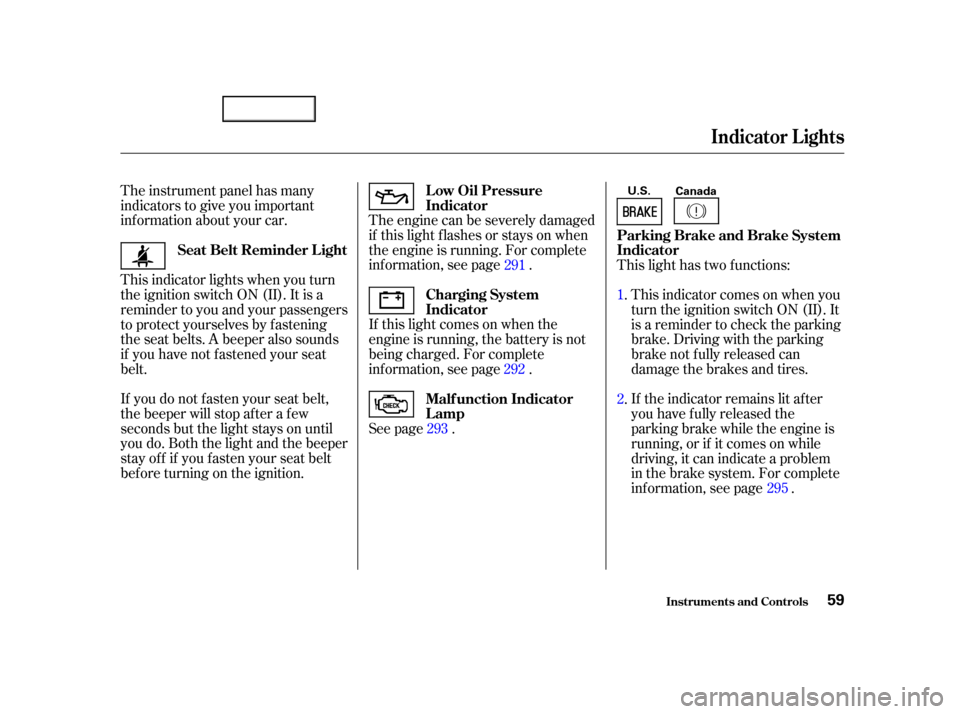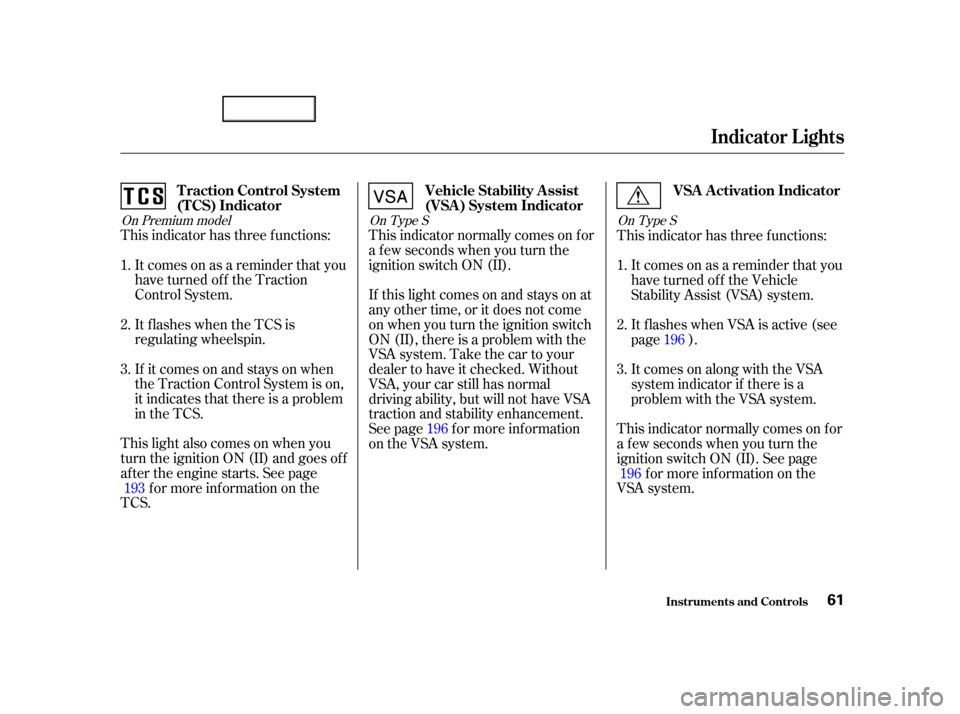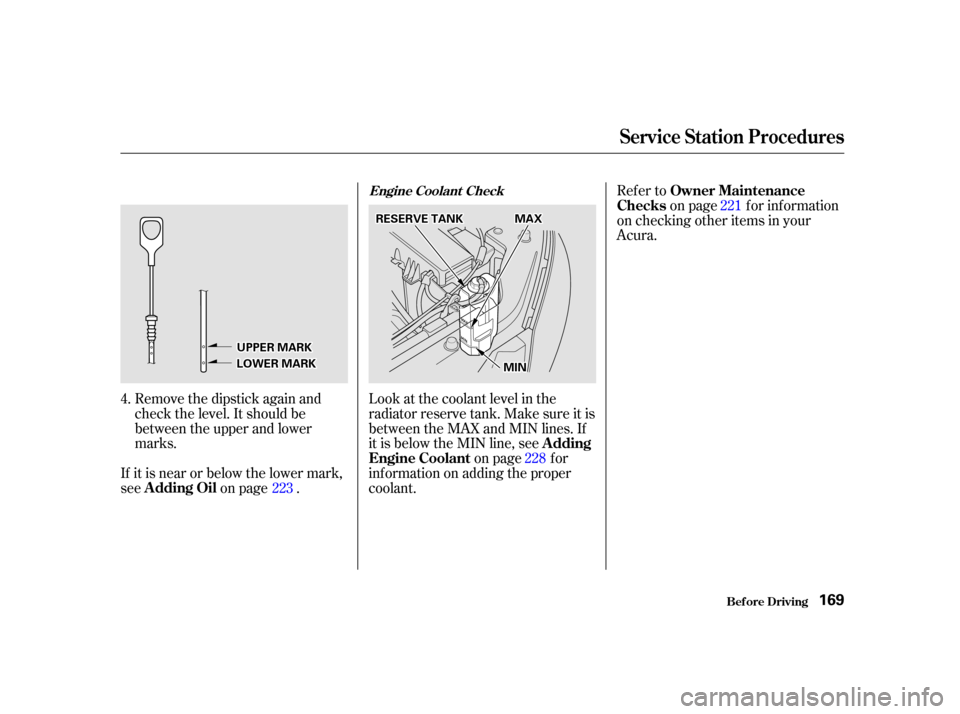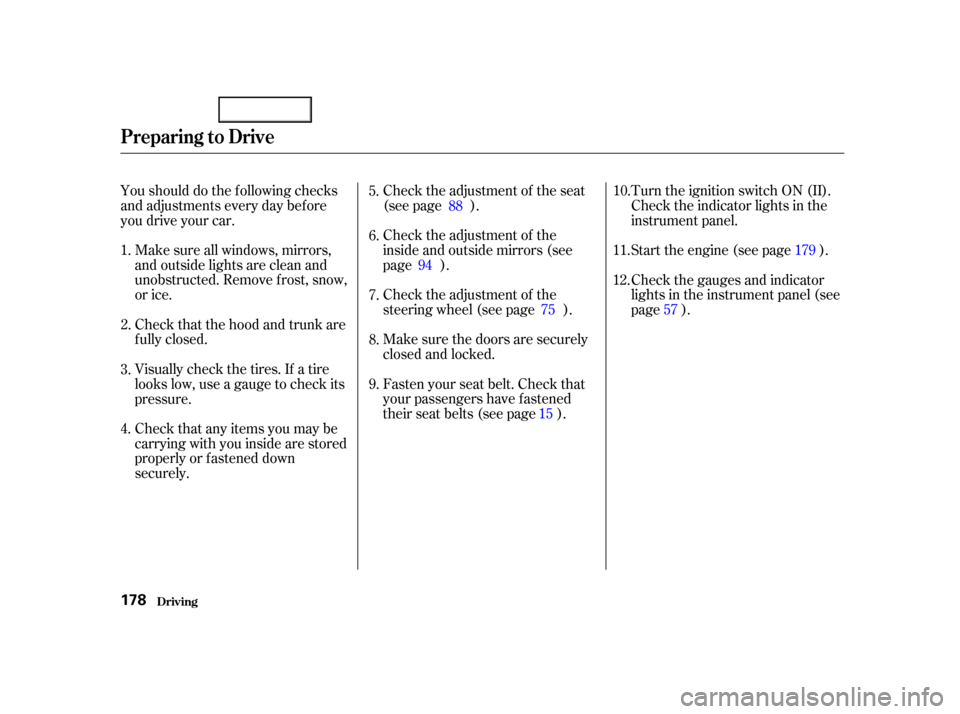check engine Acura TL 2002 3.2 Owner's Manual
[x] Cancel search | Manufacturer: ACURA, Model Year: 2002, Model line: TL, Model: Acura TL 2002Pages: 339, PDF Size: 4.71 MB
Page 53 of 339

If the SRS indicator light does not
come on after you turn the ignition
ON (II).
If the light stays on after the
engine starts.
If the light comes on or f lashes on
andoff whileyoudrive.
If the light comes on at any other
time, or does not come on at all, you
should have the system checked by
your dealer. For example:
When you turn the ignition ON (II),
this indicator will light brief ly then
go out. This tells you that the system
is working properly. Thepurposeof theSRS
indicator light is to alert
you to a potential problem with your
f ront airbags. This light will also
alert you to a potential problem with
your automatic seat belt tensioners
(page );oryoursideairbagsor
passenger’s side airbag automatic
cutof f system (page ).
If you see any of these indications,
your f ront or side airbags may not
deploy, your passenger’s side airbag
automatic cutoff system may not
work properly, or your seat belt
tensioners may not work when you
need them. See your Acura dealer as
soon as possible.
49
45
How the SRS Indicator L ight
Works
Additional Inf ormation About Your Airbags
Driver and Passenger Saf ety50
Ignoring the SRS indicator light
can result in serious injury or
death if the airbags, cutoff
system, or tensioners do not
work properly.
Have your vehicle checked by a
dealer as soon as possible if
theSRSlightalertsyoutoa
potential problem.
00/12/25 14:01:36 31S0K630_053
Page 62 of 339

The engine can be severely damaged
if this light f lashes or stays on when
the engine is running. For complete
inf ormation, see page .
If this light comes on when the
engine is running, the battery is not
being charged. For complete
inf ormation, see page .
See page .
If you do not f asten your seat belt,
the beeper will stop af ter a f ew
seconds but the light stays on until
you do. Both the light and the beeper
stay of f if you f asten your seat belt
bef ore turning on the ignition. This indicator lights when you turn
the ignition switch ON (II). It is a
reminder to you and your passengers
to protect yourselves by f astening
the seat belts. A beeper also sounds
if you have not fastened your seat
belt. The instrument panel has many
indicators to give you important
inf ormation about your car.
This light has two f unctions:This indicator comes on when you
turn the ignition switch ON (II). It
is a reminder to check the parking
brake. Driving with the parking
brake not f ully released can
damage the brakes and tires.
If the indicator remains lit af ter
you have fully released the
parking brake while the engine is
running, or if it comes on while
driving, it can indicate a problem
in the brake system. For complete
information, see page .
1.
2.
291
292
293 295
L ow Oil Pressure
Indicator
Charging System
Indicator
Malf unction Indicator
Lamp
Seat Belt Reminder L ight
Parking Brake and Brake System
Indicator
Indicator L ights
Inst rument s and Cont rols59
Canada
U.S.
00/12/25 14:03:13 31S0K630_062
Page 64 of 339

This indicator has three f unctions:Itcomesonasareminderthatyou
have turned off the Traction
Control System.
It f lashes when the TCS is
regulating wheelspin.
If itcomesonandstaysonwhen
the Traction Control System is on,
it indicates that there is a problem
in the TCS.
This light also comes on when you
turn the ignition ON (II) and goes off
af ter the engine starts. See page f or more inf ormation on the
TCS. This indicator normally comes on f or
a f ew seconds when you turn the
ignition switch ON (II).
If this light comes on and stays on at
any other time, or it does not come
on when you turn the ignition switch
ON (II), there is a problem with the
VSA system. Take the car to your
dealer to have it checked. Without
VSA, your car still has normal
driving ability, but will not have VSA
traction and stability enhancement.
See page f or more inf ormation
on the VSA system.
Itcomesonasareminderthatyou
have turned of f the Vehicle
Stability Assist (VSA) system.
It flashes when VSA is active (see
page ).
It comes on along with the VSA
system indicator if there is a
problem with the VSA system.
This indicator normally comes on f or
a f ew seconds when you turn the
ignition switch ON (II). See page f or more inf ormation on the
VSA system. This indicator has three f unctions:
1.
2.
3.
193 1.
2.
3.
196 196
196
On Type S On Type S
On Premium model
Traction Control System
(T CS) Indicator Vehicle Stability Assist
(VSA ) System IndicatorVSA A ctivation Indicator
Indicator L ights
Inst rument s and Cont rols61
00/12/25 14:03:40 31S0K630_064
Page 69 of 339

This shows how much f uel you have.
It is most accurate when the car is on
level ground. It may show slightly
more or less than the actual amount
whenyouaredrivingoncurvyor
hilly roads.
The needle returns to the bottom
after you turn off the ignition. The
gauge shows the f uel level reading
immediately af ter you turn the
ignition switch back ON (II).
This shows the temperature of the
engine’s coolant. During normal
operation, the pointer should rise
from the bottom white mark to about
the middle of the gauge. In severe
driving conditions, such as very hot
weather or a long period of uphill
driving, the pointer may rise to near
the upper red mark. If it reaches the
red (Hot) mark, pull saf ely to the
side of the road. Turn to page f or
instructions and precautions on
checking the engine’s cooling
system.
This indicator displays the outside
temperature in Fahrenheit in U.S.
models, and in Centigrade in
Canadian models.
The temperature sensor is located in
the f ront bumper. Theref ore, the
temperature reading can be af f ected
by heat ref lection f rom the road sur-
f ace, engine heat, and the exhaust
f rom the surrounding traf f ic. This
can cause the temperature reading
not to be correct when your speed is
under 19 mph (30 km/h).
In certain weather conditions,
temperature readings near f reezing
(32°F, 0°C) could mean that ice is
f orming on the road surf ace.
289
Inst rument s and Cont rols
Gauges
Fuel Gauge
Temperature Gauge
Outside Temperature Indicator
66
00/12/25 14:04:40 31S0K630_069
Page 105 of 339

The power window system has a key-
of f delay f unction. The windows will
stilloperateforuptotenminutes
after you turn off the ignition.
Opening either f ront door cancels
the delay function. You must turn
the ignition switch ON (II) again
bef ore you can raise or lower the
windows.
If your car’s battery is disconnected
or goes dead, or the driver’s window
f use is removed, the AUTO f unction
will be disabled. The power window
system needs to be reset af ter
reconnecting the battery or installing
the f use. You should do the f ollowing.
Start the engine. Push down on
the driver’s window switch until
the window is f ully open.
Pull back on the driver’s window
switch to close the window
completely, then hold the switch
f or a second or two more.
If the power windows do not operate
properly af ter resetting, have your
car checked by an Acura dealer. 1.
2.
Power Windows
Inst rument s and Cont rols102
00/12/25 14:10:43 31S0K630_105
Page 166 of 339

Bef ore you begin driving your Acura,
youshouldknowwhatgasolineto
use, and how to check the levels of
important f luids. You also need to
know how to properly store luggage
or packages. The inf ormation in this
section will help you. If you plan to
add any accessories to your car,
please read the inf ormation in this
section f irst..............................
Break-in Period . 164
.........................................
Gasoline .164
.........
Service Station Procedures . 165
................
Filling the Fuel Tank . 165
....................
Opening the Hood .166
...............................
Oil Check .168
.........
Engine Coolant Check . 169
...............................
Fuel Economy .170
.....................
Vehicle Condition .170
...........................
Driving Habits .170
...
Accessories and Modif ications . 171
.............................
Carrying Cargo .173
Bef ore Driving
Bef ore Driving163
00/12/25 14:20:03 31S0K630_166
Page 171 of 339

Check the engine oil level every time
you f ill the car with f uel. Wait a f ew
minutes af ter turning the engine of f
bef ore you check the oil.Remove the dipstick (orange
handle). Wipe the dipstick with a clean
cloth or paper towel.
Insert it all the way back in its tube.
1. 2. 3.
Bef ore Driving
Service Station Procedures
Oil Check
168
D D
I
IPP S
ST TI
ICCK K
00/12/25 14:20:55 31S0K630_171
Page 172 of 339

Remove the dipstick again and
check the level. It should be
between the upper and lower
marks.
If it is near or below the lower mark,
see on page . Look at the coolant level in the
radiator reserve tank. Make sure it is
between the MAX and MIN lines. If
it is below the MIN line, see
on page f or
inf ormation on adding the proper
coolant. Refer to
on page f or inf ormation
on checking other items in your
Acura.
4. 223 228221
Service Station Procedures
Bef ore Driving
A dding Oil
A dding
Engine Coolant Owner Maintenance
Checks
Engine Coolant Check
169
U UP PP
PE
ER
R M
M A
AR
RKK
L
LO OW WE ER
R M
M A
AR
RKK R
RE
ES
SE ER
RV V E
E T
TA
A N
NK K M
MA
AX
X
M
M I
INN
00/12/25 14:21:05 31S0K630_172
Page 173 of 339

A cold engine uses more f uel than a
warm engine. It is not necessary to
‘‘warm-up’’ a cold engine by letting it
idle f or a long time. You can drive
away in about a minute, no matter
how cold it is outside. The engine
will warm up f aster, and you get
better f uel economy. To cut down on
the number of ‘‘cold starts,’’ try to
combine several short trips into one.
You can improve f uel economy by
driving moderately. Rapid acceler-
ation, abrupt cornering, and hard
braking use more f uel.
Always drive in the highest gear that
allows the engine to run and acceler-
ate smoothly.
Depending on traf f ic conditions, try
to maintain a constant speed. Every
time you slow down and speed up,
your car uses extra f uel. Use the
cruise control, when appropriate, to
increase f uel economy.
The condition of your car and your
driving habits are the two most
important things that affect the fuel
mileage you get.
Always maintain your car according
to the maintenance schedule. This
will keep it in top operating condition.
An important part of that mainte-
nance is the
(see page ). For
example, an underinf lated tire
causes more ‘‘rolling resistance,’’
which uses f uel. It also wears out
f aster, so check the tire pressure at
least monthly.
In winter, the build-up of snow on
your car’s underside adds weight and
rolling resistance. Frequent cleaning
helps your f uel mileage and reduces
thechanceof corrosion. The air conditioning puts an extra
load on the engine which makes it
usemorefuel.Turnoff theA/Cor
set the climate control to a higher
temperature to cut down on air
conditioning use. Use the flow-
through ventilation when the outside
air temperature is moderate.
221
Vehicle Condition
Driving Habits
Owner Maintenance
Checks
Bef ore Driving
Fuel Economy
170
00/12/25 14:21:17 31S0K630_173
Page 181 of 339

Make sure all windows, mirrors,
and outside lights are clean and
unobstructed. Remove f rost, snow,
or ice.
Check that the hood and trunk are
f ully closed.Check the adjustment of the seat
(see page ).
Check the adjustment of the
inside and outside mirrors (see
page ).
Check the adjustment of the
steering wheel (see page ).
Make sure the doors are securely
closed and locked.
Fasten your seat belt. Check that
your passengers have f astened
their seat belts (see page ).Turn the ignition switch ON (II).
Check the indicator lights in the
instrument panel.
Start the engine (see page ).
Check the gauges and indicator
lights in the instrument panel (see
page ).
Check that any items you may be
carrying with you inside are stored
properly or f astened down
securely. Visually check the tires. If a tire
looks low, use a gauge to check its
pressure.
Youshoulddothefollowingchecks
and adjustments every day bef ore
you drive your car.
3.2.
1.
4. 5.
6.
7.
8.
9. 11.
12. 10.
15 75 57
179
88
94
Preparing to Drive
Driving178
00/12/25 14:22:33 31S0K630_181